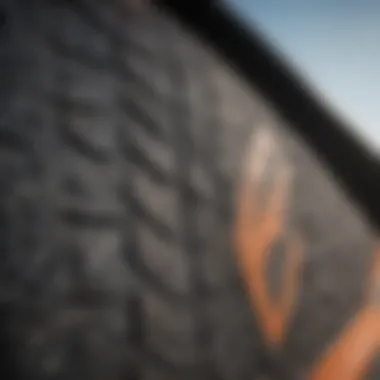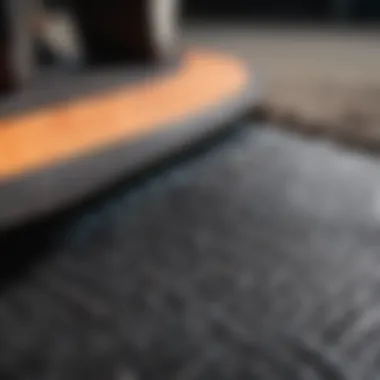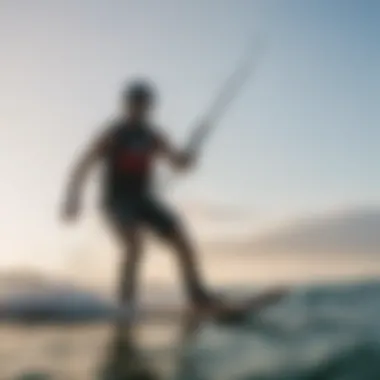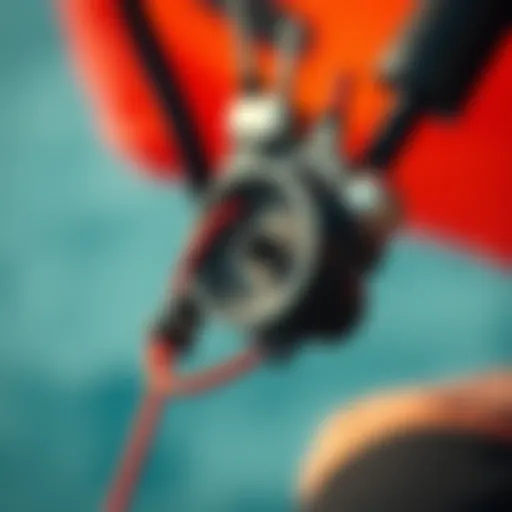Front Traction Pads: Essential Kiteboarding Gear


Intro
In the world of kiteboarding, where every nuance can influence performance, the significance of gear cannot be overstated. Among the array of equipment that kiteboarders rely on, the front traction pad stands out as a crucial component that directly impacts grip, stability, and overall riding experience. Whether you’re a budding enthusiast or a seasoned rider, understanding the intricacies of front traction pads is essential for enhancing your kiteboarding adventures.
Front traction pads are designed to provide a solid footing for the rider, ensuring that every maneuver is executed with precision. But there's more to these pads than meets the eye. Various types and materials cater to different preferences and riding styles, making it imperative to pick the right one. In this guide, we will explore not only the various types of traction pads available but also the materials that construct them, and the considerations that should guide your selection process. Furthermore, we’ll tackle some common myths surrounding these pads, ensuring that kiteboarding enthusiasts have the most accurate information at their disposal.
As we delve deeper into the world of front traction pads, we will also touch on their maintenance, ensuring they last through countless sessions on the water. Equipping yourself with the right knowledge about these pads not only helps improve your skills but also makes every outing on the water more enjoyable and efficient. So grab your gear, and let’s navigate through the critical features and benefits of front traction pads.
Understanding Front Traction Pads
In the kiteboarding arena, the front traction pad might not be the flashiest piece of gear, but it's certainly one of the most crucial components for any serious kiteboarder. Think of these pads as the unsung heroes of the sport; they offer grip, stability, and comfort that enhance your overall riding experience. Without a proper front traction pad, even the most experienced rider might find themselves in a precarious position, struggling to maintain balance and control.
The essence of understanding front traction pads lies in recognizing how they impact your ride. They are strategically designed to provide that much-needed grip on your board, especially during jumps and tricks. When a rider's weight shifts, these pads come into play, preventing slippage and maximizing performance. It's this element of control that can make or break your time on the water.
Definition and Purpose
Front traction pads serve a very specific function in kiteboarding. They are typically made from materials like foam or rubber, affixed to the front section of a board to give the rider a textured surface to stand on.
Not only do they keep you securely attached to the board, but they also assist in transferring energy and movements from your body to the board itself. This connection enhances your ability to direct speed and maneuver effectively through the water. Essentially, the purpose of these pads is to facilitate a more connected and responsive riding experience, making them a no-brainer for enthusiasts aiming to enhance their skills.
How They Enhance Performance
The performance benefits of front traction pads are multi-faceted. Firstly, they enhance grip, allowing riders to maintain their stance even under challenging conditions. Wind conditions can be fickle, and a firm grip gives you confidence to push your limits. Moreover, the right traction pad can drastically reduce fatigue over time by allowing your feet to optimally engage with the board without unnecessary slipping.
Additionally, traction pads can influence how riders execute maneuvers. For instance, during a jump, having your feet locked in can help you land more precisely. Riders who make use of these pads often find that they can generate better lift and height, translating to more impressive tricks and a significantly improved performance overall.
"A kiteboarder without a traction pad is like a chef without a knife; everything becomes more complicated and less enjoyable."
In summary, front traction pads are not just accessories but integral components of your kiteboarding gear that can enhance performance, ensure safety, and provide ultimate control. Without a firm foundation underfoot, the best laid plans in kiteboarding might just fall flat.
Types of Front Traction Pads
When it comes to optimizing your kiteboarding experience, the type of front traction pad you choose can make a noticeable difference. Understanding the various types of pads—foam, rubber, and articulated—allows riders to match their selection with their specific style and conditions. Each type exists to cater to different preferences and needs, ensuring that whether you’re soaring through waves or gliding over flat waters, there’s a suitable option for every kiteboarding enthusiast.
Foam Pads
Foam pads are some of the most popular choices among riders, primarily due to their versatility and comfort. Made from soft materials, these pads provide a cushioning effect that helps absorb shock during landings and when carving hard turns. Riders who often opt for freestyle or jumping maneuvers find foam pads advantageous.
The key benefits of foam pads include:
- Customizable Thickness: You can often find foam pads in varying thicknesses, allowing you to select the right amount of cushioning based on your personal preferences.
- Lightweight: They don't add significant weight to your setup, allowing for better maneuverability on the water.
- Enhanced Grip: Many foam options incorporate textured surfaces that increase traction, providing more confident footing.
However, foam pads might not be as durable as their rubber counterparts and can show wear more quickly if exposed to harsh conditions regularly. It's crucial to assess your riding style and frequency before settling on foam pads.
Rubber Pads
Rubber pads are known for their incredible grip and durability, making them a top pick for those who prioritize performance over cushioned comfort. Designed to withstand harsh environments, these pads provide a firm and stable surface for your feet while kiteboarding.
Some distinct advantages of rubber pads are:
- Exceptional Durability: Rubber is tough; these pads can endure the rigors of aggressive riding, making them a long-term investment
- Weather Resistance: They handle saltwater and UV exposure well, maintaining their performance even after countless sessions.
- Superior Traction: Rubber pads often feature advanced grip patterns, ensuring you won’t be slipping around—particularly beneficial during those high-speed maneuvers.
On the downside, rubber pads might feel harder underfoot, which can lead to discomfort over long periods. Riders who enjoy longer sessions may need to weigh these factors.
Articulated Pads
Articulated pads are a more recent innovation in the world of kiteboarding. These pads are designed to move with your feet instead of staying rigid, providing a balance of comfort and control. This flexibility can enhance the overall riding experience.


Key features and benefits include:
- Dynamic Movement: The articulation allows for better foot movement, making it easier to adjust your stance quickly without losing contact with the board.
- Comfort and Support: With various design options, these pads often have ergonomic shapes that fit more naturally underfoot, reducing strain during long hours of riding.
- Personalized Fit: Many articulated pads come in shapes that can be customized or adjusted, catering to the specific foot shape and riding style of the user.
However, they can sometimes be more costly than other types due to their specialized designs, which is something to consider when budgeting.
Choosing the right front traction pad is not just about comfort—it's about enhancing your performance and adaptability on the water. Each type offers unique advantages, catering to different rider preferences and requirements.
Material Considerations
When diving into the world of front traction pads, understanding the underlying materials is paramount. The type of material used directly influences not only the durability of the pad but also how it performs in different conditions. Whether you're gliding over flat water or tackling choppy waves, knowing what your gear is made from can be the difference between a smooth ride and an uncomfortable jolt.
Durability Factors
Durability is a cornerstone of any outdoor sporting gear, and front traction pads are no exception. Kiteboarding inherently exposes equipment to harsh elements. Saltwater, sand, and UV rays can wear down materials quickly. Thus, it's essential to select pads constructed from robust materials.
For instance, pads made from closed-cell foam typically resist compression and maintain their shape, even after extended use. This type of foam doesn’t absorb water, minimizing the risk of mold or degradation over time. Meanwhile, rubber pads, known for their flexibility, offer impressive resilience, bouncing back even when faced with harsh impacts.
Proper material choice also reduces the chances of premature replacement, leading to a better return on investment. A quality pad can withstand the test of time and performance, sparing you the headache of frequent shopping for new gear. Having pads that stand up to wear can make your kiteboarding sessions far more enjoyable because you won't be worried about your equipment's reliability.
Weight and Stability
After durability, weight plays a critical role in the effectiveness of front traction pads. Generally speaking, lighter pads enhance mobility, allowing for quicker adjustments mid-air and a more agile feel on the board. However, it's not just about lightweight materials; stability must also be factored in.
Heavier pads might provide a feeling of sturdiness, anchoring your feet and fostering a solid connection with the board, which some riders prefer during high-speed maneuvers or tricky landings. Yet, if the weight is unjustifiable, it can hinder the overall performance. Finding that sweet spot is essential—a pad that's light enough for agility but solid enough to provide the grip and responsiveness needed.
- Key Considerations for Weight and Stability:
- Material Thickness: Thicker pads generally offer more cushioning but tend to weigh more.
- Design Efficiency: Streamlined designs can shed excess weight while retaining stability.
- Personal Preference: Every rider has a unique feel; consider your own riding style when evaluating weight.
Ultimately, balancing these two elements—durability and weight—shapes the overall performance of any kiteboarding session. Armed with this knowledge, you can make a more informed decision on the most suitable material for your front traction pad.
Choosing the Right Front Traction Pad
Selecting the appropriate front traction pad is fundamental for enhancing your kiteboarding experience. With the wide variety of options on the market, it is crucial to consider specific factors to ensure that your choice aligns with your particular riding style and conditions. The right pad can make all the difference in your performance, providing necessary grip and stability that contributes to better control and confidence while navigating various conditions.
Size and Fit
When it comes to size and fit, precision matters. A traction pad that’s too small can leave your feet feeling unstable, while one that's too large may make it cumbersome and hard to maneuver. Here are key points to consider:
- Foot Size and Shape: Everyone's foot is different. Pads should accommodate your foot shape without crowding.
- Board Compatibility: Check the pad size against your board dimensions. Ideally, the pad should bridge the gap between your foot's position and the edges of the board.
- Riding Style: Freestyle riders may prefer smaller pads for enhanced movement, while wave surfers might lean toward larger pads that offer more surface area for balance and control.
- Try Before You Buy: If possible, test out different sizes before committing, as every manufacturer’s sizing might differ slightly.
Grip Texture and Design
Grip texture is not merely an aesthetic aspect; it plays a significant role in traction and comfort. The right texture ensures that your feet stay in place, reducing the risk of slip during high-speed maneuvers.
- Material Variation: Front pads come in various textures, including smooth, diamond patterns, or hexagonal shapes. Each provides different levels of grip. For instance, a rough texture can help keep your feet rooted without the need for constant pressure.
- Weather Resistance: Some designs are crafted with specific weather conditions in mind. A grip that functions well in dry conditions might not perform the same when wet. Consider where you'll be riding the most.
- Personal Preference: Ultimately, the grip should feel good to you. Some riders prefer a firmer grip while others might want something softer.
"Choosing the right grip could mean the difference between a perfect landing and a wipeout."
Cost Considerations
Price can often be a determining factor, yet it should not overshadow other essential aspects of selecting a front traction pad. Here are some cost-related factors to keep in mind:
- Quality over Price: Higher-priced pads sometimes offer superior materials and longer durability. Investing in a quality pad can save you money in the long run as it lasts longer and performs better.
- Brand Reputation: Established brands might charge more, but they often have better customer support and product quality. Make sure to read reviews or forums for insights into the product's longevity.
- Sales and Discounts: Keep an eye out for seasonal discounts or promotions, particularly before holiday seasons. Purchasing at the right time could lead to significant savings without compromising on quality.
- Long-term Use: Think about how often you kiteboard. A well-chosen pad can enhance your performance over many rides, so it might be worth splurging a bit more for a better product.
Taking all these elements into account when choosing the right front traction pad can lead to a more enjoyable and effective kiteboarding experience. The blend of size, grip, and cost creates a triangle of decision-making that tailors directly to you as a rider.
Installation of Front Traction Pads


When it comes to kiteboarding, proper installation of front traction pads is more than just a procedural step—it's a crucial element that can significantly affect your ride quality. A well-installed pad can enhance grip and stability, preventing unwanted slips that might lead to a tumble. Missing the mark on this task can result in compromised performance and potential safety hazards.
The installation process should not be rushed. Taking the time to carefully align and attach your front traction pads will pay dividends on the water. A precise fit aids in comfort, allowing you to focus on your technique without worrying about foot placement or traction issues. Moreover, a correct installation ensures that the pads withstand the harsh elements of water, salt, and sun that kiteboarders often encounter.
Step-by-Step Guide
- Prepare Your Board: Start by cleaning the area where the pad will be applied. Remove any dust, dirt, or wax that could prevent proper adhesion. A good standard is to use isopropyl alcohol on a lint-free cloth to ensure the surface is spotless.
- Align the Pads: Before you peel off the backing, position the pads on the board to see how they fit. It’s recommended to place them where your feet naturally land when stabilizing yourself.
- Remove Backing and Apply: Carefully peel the backing from the pads. Start from one end, gradually sticking it down to avoid air bubbles. Press firmly as you go, ensuring that each section adheres well.
- Secure the Edges: After the entire pad is applied, press down along the edges. Sometimes, air pockets can form, so going over it with a roller or even your hand, making sure that the pads are glued down securely.
- Allow to Cure: Finally, let the adhesive cure as per the manufacturer’s instructions before using your board. This step is crucial; otherwise, you might find your pads loosening or moving unexpectedly.
Common Mistakes to Avoid
When installing front traction pads, there are several pitfalls that you might encounter. Avoiding these errors could save you from frustration later on.
- Ignoring Surface Prep: Not cleaning the board properly can lead to poor adhesion. Always take the time to clean the area thoroughly.
- Misalignment: Ensure that the pads are positioned according to your footwork style; misalignment can affect your balance significantly.
- Skipping the Cure Time: Rushing the process by using the board too soon after installation can lead to pads coming off or becoming misaligned. Following curing times is essential for lasting attachment.
- Trying to Reposition: Once a pad is set, avoid lifting it to reposition. This can weaken the adhesive bond and may prevent it from sticking correctly.
“Proper installation of your front traction pads is as vital as selecting the right ones; it's about creating the perfect synergy between rider and equipment.”
In summary, taking a methodical approach when installing front traction pads can lead to better performance on the water, enhancing both your skill and enjoyment of kiteboarding. With the right steps and attention to detail, you're not only installing a piece of gear, but investing in a more effective and enjoyable ride.
Maintenance Tips for Longevity
Keeping your front traction pad in tip-top shape not only ensures better performance on the water, it also extends the life of the gear. The wear and tear from saltwater, sand, and UV exposure can quickly degrade the materials used in pads. By dedicating a bit of time to routine maintenance, kiteboarders can avoid costly replacements down the line and enjoy a smoother ride.
Cleaning Procedures
After a day on the water, it's tempting to just toss your gear in the corner and call it a day. However, a simple cleaning routine goes a long way.
- Rinse Off: Start by rinsing your traction pad with fresh water. This step removes harmful salt and sand that can cause wear over time.
- Use Mild Soap: A gentle soap solution is perfect for a deeper clean. Avoid harsh chemicals which could break down the pad material. A sponge or soft cloth works like a charm.
- Dry Thoroughly: Give your traction pads a good shake to remove excess water, then let them air dry completely before storing. Storing them wet can foster mold and mildew, which won’t do your gear any favors.
Incorporating this cleaning routine can make all the difference. Regularly maintaining the pad not only keeps it looking fresh but preserves its grip and function over the long haul.
Storage Recommendations
Where and how you store your gear can be just as important as how you clean it. Here are some handy tips for ensuring your front traction pad stays in great condition while not in use:
- Cool, Dry Spot: Store your pads in a cool, dry place away from direct sunlight. Prolonged exposure to sunlight can cause fading and degradation.
- Avoid Heavy Loads: Don’t stack heavy items on top of your pads. This can create pressure that compromises their shape and support.
- Use a Protective Bag: If possible, store your pads in a padded gear bag. This offers extra protection from impact and environmental elements.
Tip: If traveling, keep your pads flat in your bag rather than rolled up. This helps maintain their structure and prevents unnecessary creasing.
By being mindful about cleaning and storage, kiteboarders can enhance the longevity of their front traction pads significantly, leading to improved performance and prolonged enjoyment on the water. Remember, a well-maintained pad is one that can confidently take on the waves, ensuring you stay safe and stylish!
Common Misconceptions
Understanding the common misconceptions surrounding front traction pads is critical for kiteboarding enthusiasts. These myths can lead to misunderstandings, affecting gear selection and overall kiteboarding experiences. Clearing up these misconceptions not only enhances performance on the water but also fosters better decision-making among riders of all levels. Here, we address two prevalent myths and explore the nuances of grip variations.
Myths About Traction Pads
One prevalent myth is that all front traction pads are created equal. This assumption overlooks the diverse range of pad types and their specific functions. For instance, some riders believe that merely having a traction pad is enough to ensure a stable ride. However, the effectiveness of a pad often depends on its material, design, and how well it complements the board and the rider's style.
Another myth is the belief that thicker pads offer better grip. While it’s true that thickness can contribute to comfort, it doesn’t necessarily correlate with grip performance. Many experienced riders choose thinner pads, valuing direct contact with the board over added cushioning. Choosing the right traction pad means delving deeper than surface-level assumptions. Riders should consider personal comfort, usage context, and compatibility with their riding style.
Understanding Grip Variations
Grip variation is another area rife with misunderstandings. Some kiteboarders think that all grip textures will enhance their ability to control the board efficiently. In reality, different textures interact with the rider's feet in unique ways. Rougher textures can provide a stronger grip but may lead to discomfort during extended sessions. Meanwhile, smoother surfaces allow for easier foot adjustments but might not offer the same level of control in high-stress maneuvers.
Moreover, riders must consider how weather and sea conditions impact grip performance. For example, wet conditions can compromise many traction pads, making them slippery. Understanding these variations empowers riders to choose pads that align not just with personal preference but also with specific riding contexts.
Proper education on the characteristics of traction pads and their respective grips can significantly enhance a rider’s kiteboarding experience.
By debunking myths and grasping the intricacies of grip variations, kiteboarding enthusiasts can better navigate the continued progression of their skills. Armed with this knowledge, selecting the right gear becomes a more informed endeavor, ultimately translating into a more enjoyable time on the water.


Integration With Other Gear
When it comes to kiteboarding, the importance of integrating various gear cannot be overstated. Each component, including the front traction pad, has a specific role, and understanding how they interconnect is key to enhancing your performance on the water. Integrating these elements not only ensures comfort and control but also maximizes efficiency in your movements. Here, we’ll dive into the essential aspects of this integration, focusing on compatibility with boards and synergy with footstraps.
Compatibility with Boards
Choosing a front traction pad isn’t just about its grip or style; it’s about how well it works with your board. Kiteboard designs vary widely, so it's crucial to match the pad with the board for optimal performance. Many riders overlook this factor, thinking that any pad will do. However, the fit can dramatically affect your riding experience.
- Board Shape: Different board shapes require specific pad designs. For example, a wider board may need a larger traction pad to ensure stability and grip during jumps.
- Thickness and Material: The thickness of the pad can affect how you feel the board beneath your feet, and its material should complement the board for durability and performance.
- Attachment Method: Some boards are set up to accommodate pads with specific attachment systems. Ensuring compatibility here can make installation straightforward and more secure.
By selecting a pad that not only fits your feet but also aligns perfectly with your board’s specifications, you elevate your riding to a whole new level. It’s about harnessing that connection with the board, allowing sharp turns and swift maneuvers without losing that critical grip.
"A good connection with your board can mean the difference between a flawless run and a wipeout."
Synergy With Footstraps
To maximize your performance in kiteboarding, the harmony between your front traction pads and footstraps is of utmost importance. Footstraps serve to anchor your feet securely to the board, while traction pads provide the necessary grip.
When discussing synergy between these two elements, consider the following:
- Foot Positioning: The placement of your foot over the traction pad needs to work in tandem with how the footstraps are set. If your foot is too far back or too far forward, not only does this affect balance, but also your ability to steer the kite effectively.
- Grip and Support: An ideal setup will allow your feet to move slightly when needed, yet provide solid grip when you are airborne. This interplay can enhance your agility during riding.
- Personal Adjustment: Every rider has different preferences regarding how tight or loose they like their footstraps. Having traction pads that accommodate easy adjustments can make a significant difference, especially during long sessions.
Finding the right balance means experimenting with both the pads and footstraps to discover what arrangement feels best for your unique riding style. It’s all about feeling at one with your gear, translating to superior confidence as you tackle those waves.
Performance Insights
Performance insights are crucial when discussing front traction pads. Understanding how these pads influence your kiteboarding might be the difference between a good session and a great one. The right front traction pad can provide enhanced grip and stability, essential for executing maneuvers and maintaining control in various wind conditions. By analyzing feedback from experienced riders and the impact on riding techniques, we can grasp the value that these components add to the overall kiteboarding experience.
Feedback from Experienced Riders
Hearing from those who’ve invested time and energy into kiteboarding adds some serious weight to any discussion. Experienced riders often share that front traction pads significantly alter their performance on the water. Many cite distinct improvements in their ability to steer their boards effectively and maintain a solid footing during jumps.
For instance, a rider might note how foam pads offer ample cushioning, which allows for light landings after aerial tricks. Others might prefer rubber pads for their sticky feel, providing that extra layer of assurance when carving through challenging waves. The choice of pad impacts mechanics; a rider who feels secure under their feet is likely to push their limits more confidently. Here's a summary of what seasoned kiteboarders frequently talk about:
- Improved Feedback: More sensitivity in movements allows quicker reactions.
- Increased Comfort: Reduces fatigue over long sessions.
- Control: Boosts confidence during difficult maneuvers.
"Having the right front traction pad transformed my riding. The grip and feel make all the difference, especially when the wind picks up," says a seasoned kiteboarder from the coast of Oregon.
Impact on Riding Techniques
Front traction pads don't just add comfort; they can reshape how one approaches riding. With improved grip, riders often find they can experiment with new techniques and styles. For example, those using articulated pads may notice that their foot placement becomes more instinctive, which can lead to more fluid transitions between moves.
Moreover, the style of riding may change according to pad choice. More aggressive pads might encourage harder edging and more dynamic movements, while softer, cushioned pads may lead to smoother, more flowing techniques. Here are couple of key aspects riders have noticed:
- Jump Techniques: The added grip allows for better takeoffs and landings, enhancing overall aerial performance.
- Carving and Turns: A secure foot connection helps with sharper turns and increased precision during fast maneuvers.
All things considered, investing in or carefully selecting the right front traction pad could set the stage for not just improved stability but a spectrum of new riding techniques. The synthesis of experience and equipment utility can lead to richer, more dynamic kiteboarding sessions.
Epilogue
The discussion around front traction pads plays a vital role in understanding their significance in the kiteboarding realm. These pads are not just a piece of gear; they are essential components that directly influence a rider's experience on the water. Their importance lies in several key elements.
Summarizing Key Points
- Grip and Stability: Front traction pads enhance a rider's grip, leading to improved control over the board. This stability can be the difference between a smooth ride and an unexpected tumble.
- Material Choices: Various materials like foam and rubber provide distinct advantages, impacting factors like durability and weight. Understanding these choices helps in selecting the right gear tailored to specific riding conditions.
- Type Selection: Depending on riding style and preference, the choice between articulated, foam, or rubber pads can significantly affect performance.
- Compatibility with Gear: Knowing how front traction pads integrate with other equipment, such as boards and footstraps, is crucial for achieving an optimal setup.
- Maintenance and Longevity: Proper upkeep ensures these pads serve well over time, maintaining their functionality and appearance.
In short, when kiteboarders carefully consider these points, they can enhance their riding experience dramatically. Choosing the right front traction pad is not merely an afterthought; it is an informed decision that shapes every session out on the water.
Final Thoughts on Selection
Selecting the ideal front traction pad goes beyond mere taste. Kiteboarders ought to consider their skill level, the type of kiteboarding they engage in, and the typical conditions they face. Each pad type offers unique benefits, and it’s essential to weigh these against personal preferences.
Moreover, experimentation can yield valuable insights. Trying different pads in various setups can reveal what works best for an individual's riding style.
As such, it's wise to keep an open mind and not shy away from recommendations from more seasoned riders. Fueling one’s passion for kiteboarding involves the right gear, and front traction pads are an integral part of that mix. Finding the right fit and ensuring comfort will pay dividends in performance, allowing riders to fully immerse themselves in the thrill of the sport.















